engine Citroen DS3 2014 1.G Workshop Manual
[x] Cancel search | Manufacturer: CITROEN, Model Year: 2014, Model line: DS3, Model: Citroen DS3 2014 1.GPages: 376, PDF Size: 12.55 MB
Page 193 of 376
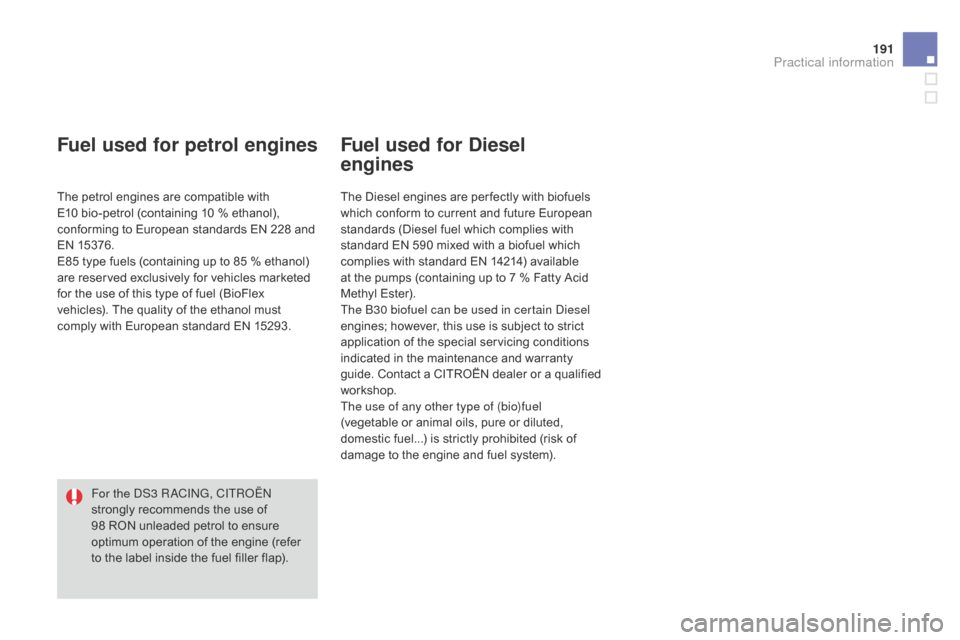
191
DS3_en_Chap10_info-pratiques_ed01-2014
Fuel used for petrol engines
The petrol engines are compatible with E10 bio-petrol (containing 10 % ethanol),
c
onforming to European standards EN 228 and
E
N
1
5376.
E85
type fuels (containing up to 85 % ethanol)
a
re reserved exclusively for vehicles marketed
f
or the use of this type of fuel (BioFlex
v
ehicles). The quality of the ethanol must
c
omply with European standard EN 15293.
Fuel used for diesel
engines
The Diesel engines are per fectly with biofuels w
hich conform to current and future European
s
tandards (Diesel fuel which complies with
s
tandard EN 590 mixed with a biofuel which
c
omplies with standard EN 14214) available
a
t the pumps (containing up to 7 % Fatty Acid
M
ethyl Ester).
The
b
3
0 biofuel can be used in certain Diesel
engines;
however, this use is subject to strict
a
pplication of the special servicing conditions
i
ndicated in the maintenance and warranty
g
uide.
C
ontact
a
C
ITROËN
d
ealer
o
r
a
q
ualified
w
orkshop.
The use of any other type of (bio)fuel
(vegetable
or animal oils, pure or diluted,
d
omestic fuel...) is strictly prohibited (risk of
d
amage to the engine and fuel system).
For the DS3 R
aC
ING, CITR
oË
N
strongly
recommends
the
use
of
9
8
RON
unleaded
petrol
to
ensure
o
ptimum
operation
of
the
engine
(refer
t
o
the
label
inside
the
fuel
filler
flap).
Practical information
Page 194 of 376
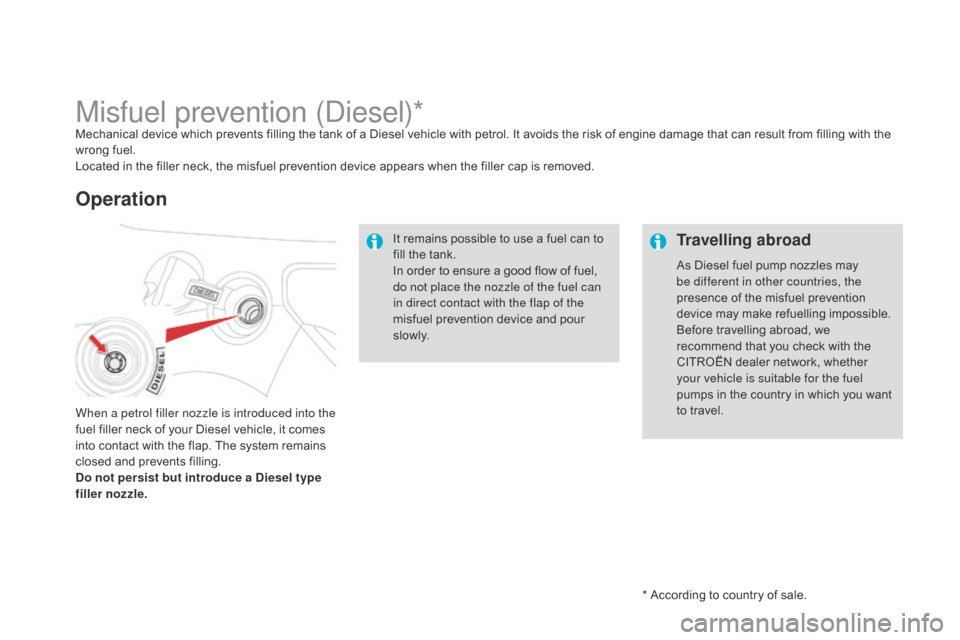
DS3_en_Chap10_info-pratiques_ed01-2014
* According to country of sale.
Misfuel prevention (Diesel)*Mechanical device which prevents filling the tank of a Diesel vehicle with petrol. It avoids the risk of engine damage that can result from filling with the wrong fuel.
Located
in the filler neck, the misfuel prevention device appears when the filler cap is removed.
Operation
When a petrol filler nozzle is introduced into the
fuel filler neck of your Diesel vehicle, it comes
i
nto contact with the flap. The system remains
c
losed and prevents filling.
do n
ot persist but introduce a d
i
esel type
filler nozzle. It
remains possible to use a fuel can to
f
ill the tank.
In order to ensure a good flow of fuel,
d
o not place the nozzle of the fuel can
in direct contact with the flap of the
misfuel prevention device and pour
s
l ow l y.
Travelling abroad
As Diesel fuel pump nozzles may b
e different in other countries, the
presence
of the misfuel prevention
d
evice may make refuelling impossible.
Before
travelling abroad, we
r
ecommend that you check with the
C
ITROËN dealer network, whether
y
our vehicle is suitable for the fuel
pumps
in the country in which you want
t
o travel.
Page 195 of 376
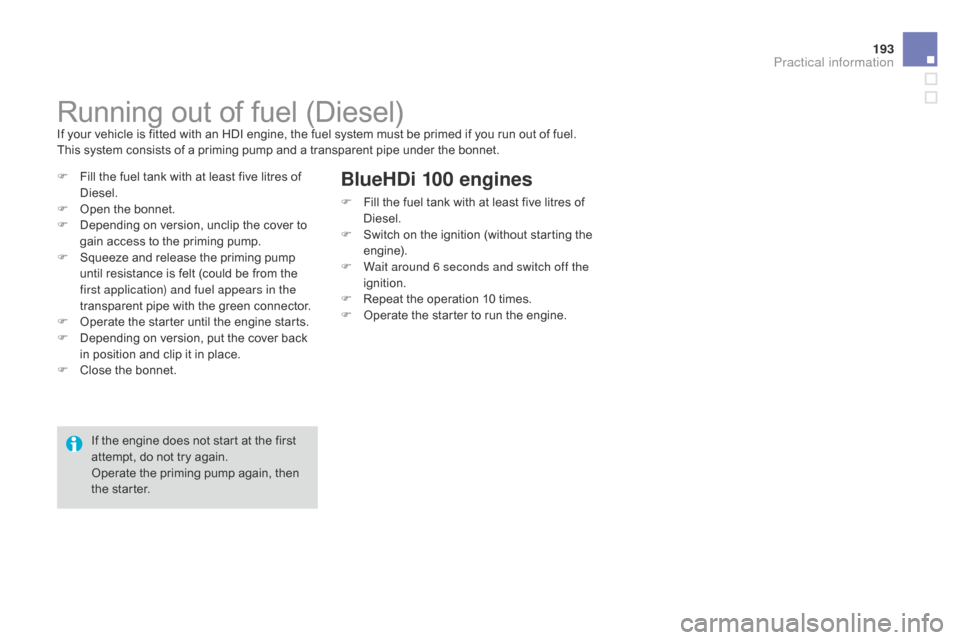
193
DS3_en_Chap10_info-pratiques_ed01-2014
Running out of fuel (Diesel)If your vehicle is fitted with an HDI engine, the fuel system must be primed if you run out of fuel.
T his system consists of a priming pump and a transparent pipe under the bonnet.
F
F
ill the fuel tank with at least five litres of
D
iesel.
F
O
pen the bonnet.
F
D
epending on version, unclip the cover to
g
ain access to the priming pump.
F
S
queeze and release the priming pump
u
ntil resistance is felt (could be from the
f
irst application) and fuel appears in the
transparent
pipe with the green connector.
F
O
perate the starter until the engine starts.
F
D
epending on version, put the cover back
i
n position and clip it in place.
F
C
lose the bonnet.
BlueHdi 100 engines
F Fill the fuel tank with at least five litres of D
iesel.
F
S
witch on the ignition (without starting the
e
ngine).
F
W
ait around 6 seconds and switch off the
ignition.
F
R
epeat the operation 10 times.
F
O
perate the starter to run the engine.
If
the
engine
does
not
start
at
the
first
a
ttempt,
do
not
try
again.
Operate
the
priming
pump
again,
then
t
he
starter.
Practical information
Page 196 of 376

DS3_en_Chap10_info-pratiques_ed01-2014
adblue® additive and SCR system
f
or
Blue
HDi Diesel engines
To assure respect for the environment and c
onformity with the new Euro 6 emissions
s
tandard, without adversely affecting the
p
er formance or fuel consumption of Diesel
e
ngines, CITROËN has taken the decision to
e
quip its vehicles with an effective system that
a
ssociates SCR (Selective Catalytic Reduction)
with
a particle filter (FAP) for the treatment of
e
xhaust gases.
Presentation of the ScR s ystem
Using an additive called AdBlue® containing u
rea, a catalytic converter turns up to
85% of
nitrous
oxides
(NOx)
into
nitrogen
a
nd
water,
which
are
harmless
to health and
t
he environment. The
a d
blu
e
® additive is held in a special
tank
located
under the boot at the rear of
t
he
vehicle.
It has a capacity of 17 litres: this
p
rovides
a
driving range of about 12 500 miles
(
20
000
km),
after which an alert is triggered
w
arning
you
when the reserve remaining is
e
nough
for
just 1 500 miles (2 400 km).
During
each
scheduled service of your vehicle
b
y
a
CITROËN dealer or a qualified workshop,
t
he
a
d
blu
e
® additive tank is refilled in order to a
llow
normal operation of the SCR system.
If
the
estimated mileage between two services
i
s
greater
than 12 500 miles (20 000 km), we
r
ecommend
that you go to a CITROËN dealer
o
r
a
qualified workshop to have the necessary
t
op-up
carried out.
on
ce the a
dbl
ue
® tank is empty, a
system
required
by regulations
p
revents
starting
of the engine.
If the SCR
is faulty, the level of
emissions
from
your vehicle will no
l
onger
meet
the
Euro 6 standard: you
v
ehicle
becomes
polluting.
In
the
event
of
a
confirmed fault
w
ith
the
SCR
system, you must go
t
o a CITR
oË
N dealer or a qualified
workshop
as
soon as possible: after
a
running
distance of 650 miles
(
1 100
km),
a
system will be triggered
a
utomatically
to
prevent engine
s
tarting.
Page 197 of 376
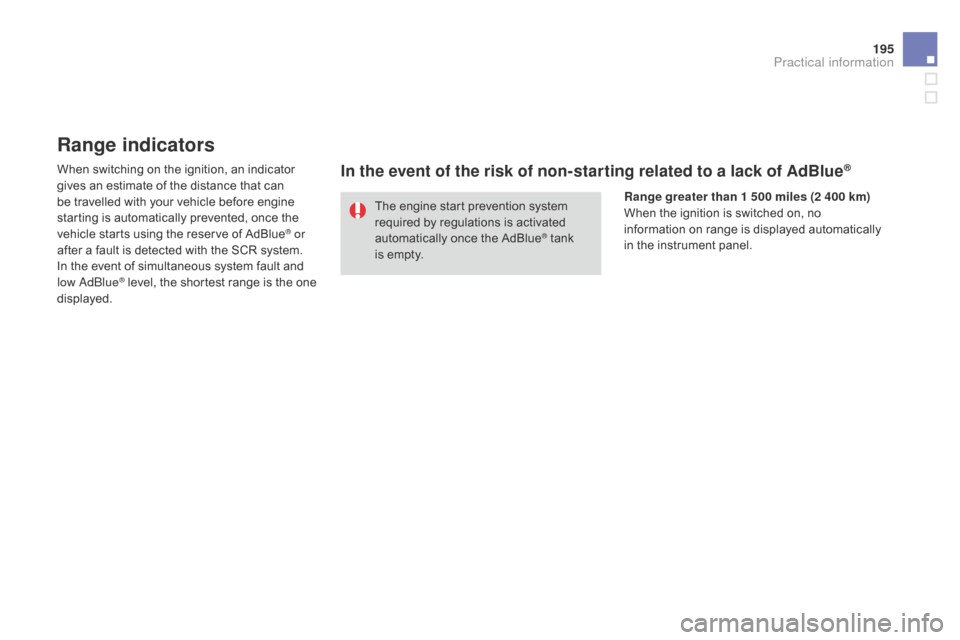
195
DS3_en_Chap10_info-pratiques_ed01-2014
Range indicators
When switching on the ignition, an indicator gives an estimate of the distance that can
b
e travelled with your vehicle before engine
s
tarting is automatically prevented, once the
v
ehicle starts using the reserve of AdBlue
® or
after
a
fault
is
detected
with
the
SCR
system.
In
the
event
of
simultaneous
system
fault
and
l
ow
a
d
blu
e
® level, the shortest range is the one d
isplayed. The
engine start prevention system
r
equired by regulations is activated
a
utomatically once the AdBlue
® tank i
s
empty.
In the event of the risk of non-starting related to a lack of AdBlue®
Range greater than 1 500 miles (2 400 km)
When the ignition is switched on, no
i
nformation on range is displayed automatically
i
n the instrument panel.
Practical information
Page 198 of 376
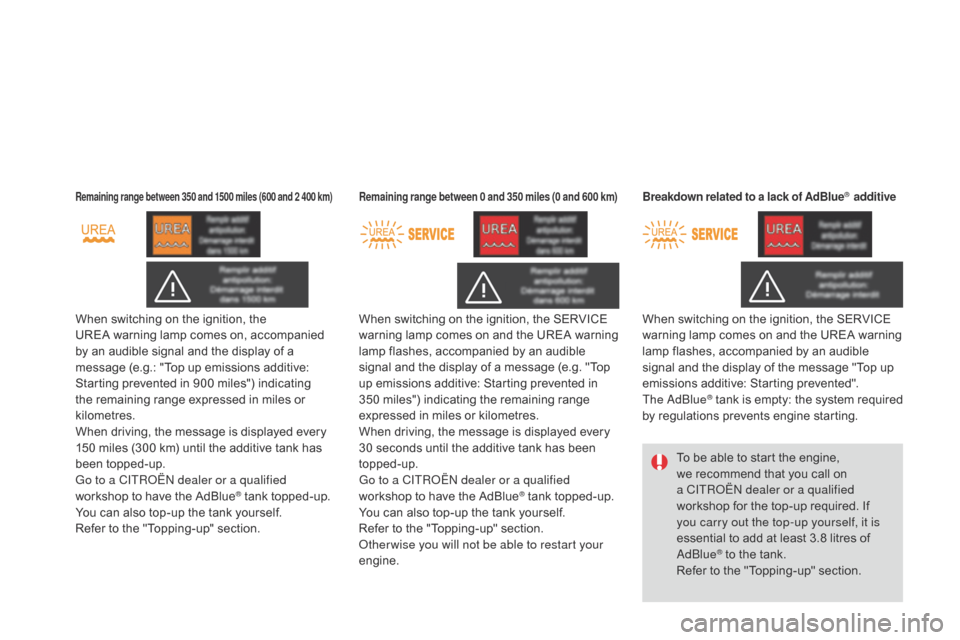
DS3_en_Chap10_info-pratiques_ed01-2014
Remaining range between 350 and 1500 miles (600 and 2 400 km)
When switching on the ignition, the UREA warning lamp comes on, accompanied
b
y an audible signal and the display of a
m
essage (e.g.: "Top up emissions additive:
S
tarting prevented in 900 miles") indicating
t
he remaining range expressed in miles or
k
ilometres.
When
driving, the message is displayed every
1
50 miles (300 km) until the additive tank has
be
en
t
opped-up.
Go to a CITR
oË
N dealer or a qualified
workshop
to have the AdBlue
® tank topped-up.
Y
ou
can
also
top-up
the
tank
yourself.
Refer
to
the
"Topping-up"
section. When
switching on the ignition, the SERVICE
w
arning lamp comes on and the UREA warning
l
amp flashes, accompanied by an audible
s
ignal and the display of a message (e.g. "Top
u
p emissions additive: Starting prevented in
3
50 miles") indicating the remaining range
e
xpressed in miles or kilometres.
When driving, the message is displayed every
3
0 seconds until the additive tank has been
t
opped-up.
Go to a CITR
oË
N dealer or a qualified
workshop to have the AdBlue® tank topped-up.
Y
ou
can
also
top-up
the
tank
yourself.
Refer
to
the
"Topping-up"
section.
ot
her wise you will not be able to restart your
engine.
Remaining range between 0 and 350 miles (0 and 600 km)
When switching on the ignition, the SERVICE w arning lamp comes on and the UREA warning
l
amp flashes, accompanied by an audible
s
ignal and the display of the message "Top up
e
missions additive: Starting prevented".
The
a d
blu
e
® tank is empty: t he s ystem r equired b
y
regulations prevents engine starting.
Breakdown related to a lack of AdBlue® additive
To be able to start the engine, w
e recommend that you call on
a C
ITR
oË
N dealer or a qualified
workshop
for the top-up required. If
y
ou carry out the top-up yourself, it is
essential
to add at least 3.8 litres of
a
d
blu
e
® to the tank.
R
efer
to
the "Topping-up" section.
Page 199 of 376
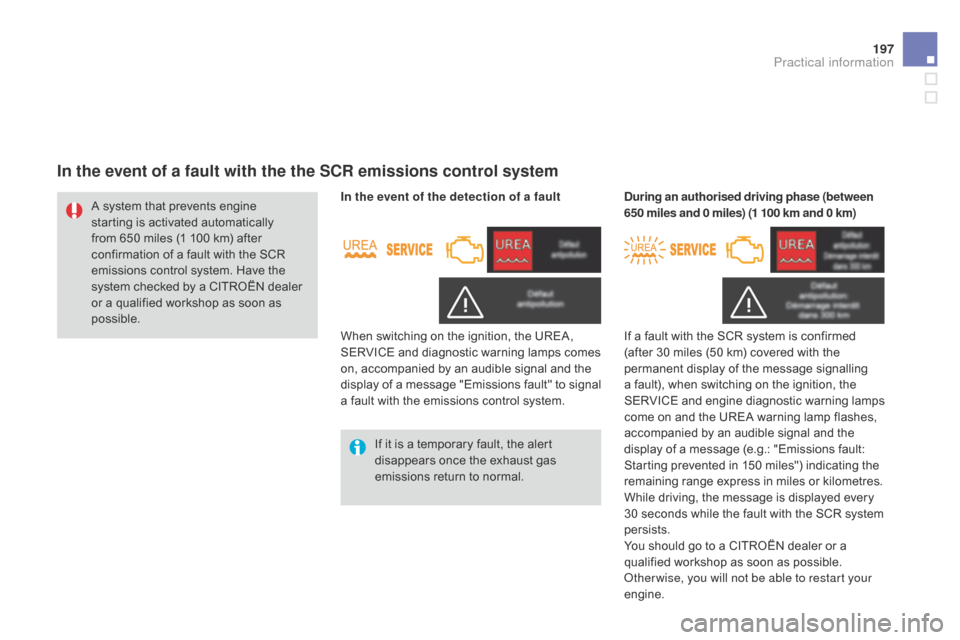
197
DS3_en_Chap10_info-pratiques_ed01-2014
In the event of a fault with the the ScR emissions control system
If it is a temporary fault, the alert d
isappears once the exhaust gas
e
missions return to normal.
A
system
that
prevents
engine
s
tarting
is
activated
automatically
f
rom
650 miles
(1
100
km)
after
c
onfirmation
of
a
fault
with
the
SCR
e
missions
control
system.
Have
the
s
ystem
checked
by
a
CITROËN
dealer
o
r
a
qualified
workshop
as
soon
as
p
ossible.
In the event of the detection of a fault
du
ring an authorised driving phase (between
650 miles and 0 miles) (1 100 km and 0 km)
When
switching on the ignition, the UREA,
S
ERVICE and diagnostic warning lamps comes
o
n,
accompanied by an audible signal and the
d
isplay
o
f
a m
essage
"
Emissions
f
ault"
t
o
s
ignal
a
fault
with the emissions control system.If a fault with the SCR system is confirmed
(
after 30 miles (50 km) covered with the
p
ermanent display of the message signalling
a
fault), when switching on the ignition, the
S
ERVICE
an
d
e
ngine
d
iagnostic
w
arning
lam
ps
c
ome on and the UREA warning lamp flashes, a
ccompanied by an audible signal and the d
isplay of a message (e.g.: "Emissions fault:
S
tarting prevented in 150 miles") indicating the
r
emaining range express in miles or kilometres.
While
driving, the message is displayed every
3
0 seconds while the fault with the SCR system
p
ersists.
You
should go to a CITROËN dealer or a
q
ualified workshop as soon as possible.
ot
her wise, you will not be able to restart your
engine.
Practical information
Page 200 of 376
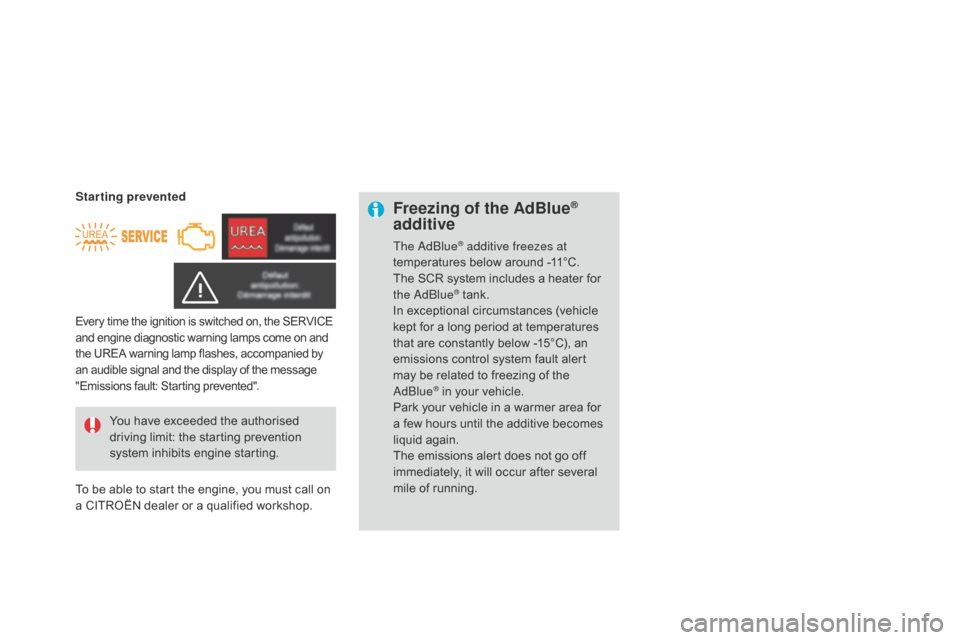
DS3_en_Chap10_info-pratiques_ed01-2014
Freezing of the AdBlue®
additive
The adblue® additive freezes at
temperatures below around -11°C.
The
SCR
system includes a heater for
t
he
a
d
blu
e
® tank.
I
n
exceptional circumstances (vehicle
k
ept
for
a
long period at temperatures
t
hat
are
constantly below -15°C), an
e
missions
control system fault alert
m
ay
be
related to freezing of the
a
d
blu
e
® in your vehicle.
P
ark
your vehicle in a warmer area for
a
few
hours until the additive becomes
li
quid
a
gain.
The
emissions alert does not go off
i
mmediately, it will occur after several
m
ile
of
running.
You
have
exceeded
the
authorised
d
riving
limit:
the
starting
prevention
s
ystem
inhibits
engine
starting.
Every time the ignition is switched on, the SERVICE a nd engine diagnostic warning lamps come on and t
he UREA warning lamp flashes, accompanied by
a
n audible signal and the display of the message
"
Emissions fault: Starting prevented".
Starting prevented
To
be able to start the engine, you must call on
a
CITROËN dealer or a qualified workshop.
Page 203 of 376
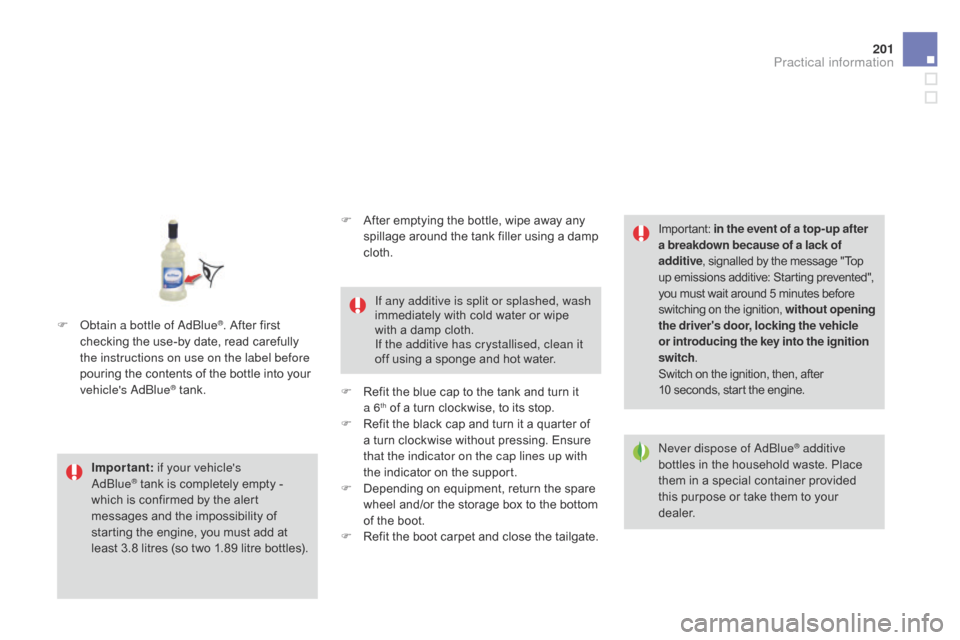
201
DS3_en_Chap10_info-pratiques_ed01-2014
Important: if your vehicle's a
dblu e® tank is completely empty - w
hich
is
confirmed by the alert
m
essages and the impossibility of
s
tarting
the engine, you must add at
l
east
3.8 litres (so two 1.89 litre bottles).If any additive is split or splashed, wash
immediately
with cold water or wipe
w
ith a damp cloth.
If the additive has crystallised, clean it
off using a sponge and hot water.Important:
i
n the event of a top-up after
a breakdown because of a lack of
additive , signalled by the message "Top
u
p emissions additive: Starting prevented",
y
ou must wait around 5 minutes before
s
witching
o
n
t
he
i
gnition,
w
ithout opening
the driver's door, locking the vehicle
or introducing the key into the ignition
switch .
Switch on the ignition, then, after
1
0 seconds, start the engine.
F
o
b
tain a bottle of a
dbl
ue
®. After first c
hecking
the
use-by
date,
read carefully
t
he instructions on use on the label before
pouring
the
contents
of
the bottle into your
v
ehicle's
a
d
blu
e
® tank. N ever dispose of a
dbl
ue
® additive
bottles
in
the
household
waste. Place
t
hem
in
a
special
container provided
t
his
purpose
or
take
them
to your
d
ealer.
F
A
fter
emptying
the
bottle,
wipe
away
any
s
pillage
around
the
tank
filler
using
a
damp
c
loth.
F
R
efit
the
blue
cap
to
the
tank
and
turn
it
a
6
th of a turn clockwise, to its stop.
F
R
efit the black cap and turn it a quarter of
a
turn clockwise without pressing. Ensure
t
hat the indicator on the cap lines up with
the
indicator on the support.
F
D
epending on equipment, return the spare
w
heel and/or the storage box to the bottom
o
f
the boot.
F
R
efit the boot carpet and close the tailgate.
Practical information
Page 228 of 376
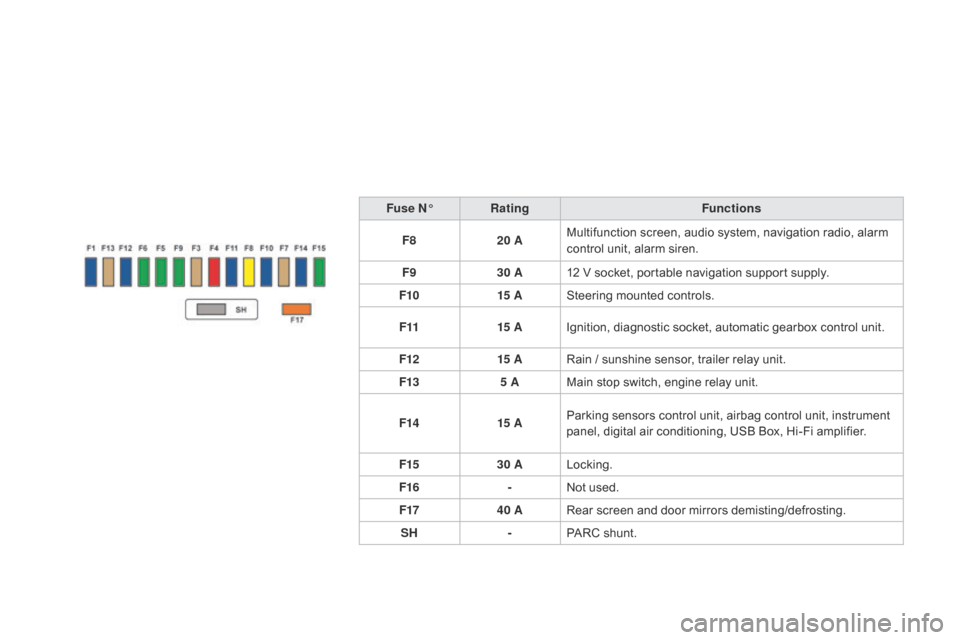
DS3_en_Chap10_info-pratiques_ed01-2014
Fuse N°Rating Functions
F8 20 AMultifunction
screen, audio system, navigation radio, alarm
c
ontrol unit, alarm siren.
F9 30 A12
V socket, portable navigation support supply.
F10 15 ASteering
mounted controls.
F11 15 AIgnition,
diagnostic socket, automatic gearbox control unit.
F12 15 ARain
/ sunshine sensor, trailer relay unit.
F13 5 AMain
stop switch, engine relay unit.
F14 15 AParking
sensors control unit, airbag control unit, instrument
p
anel, digital air conditioning, USB Box, Hi-Fi amplifier.
F15 30 ALocking.
F16 -Not
used.
F17 40 ARear
screen and door mirrors demisting/defrosting.
SH -PARC
shunt.